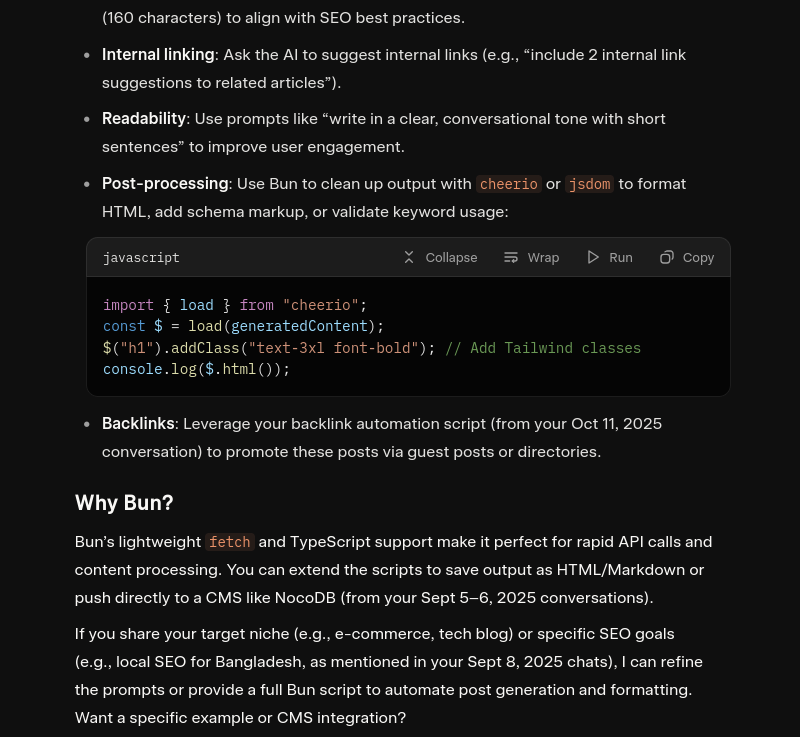Best Free AI APIs for SEO-Optimized Posts with Bun
SazzadTanim
Blogger
Best Free AI APIs for SEO-Optimized Posts with Bun
1. Hugging Face Inference API
Why it’s great for SEO: Access to models like Mistral or Llama 3.1, which can generate human-like text for blog posts, product descriptions, or articles. You can fine-tune prompts to include target keywords, meta descriptions, and structured headings (H1, H2) for SEO.
Free tier: Unlimited for community models; rate-limited (~100 requests/hour).
SEO use case: Generate keyword-rich content, meta tags, or even FAQ sections to boost on-page SEO.
Bun integration:
const response = await fetch("https://api-inference.huggingface.co/models/mixtral-8x7b", { method: "POST", headers: { "Authorization": "Bearer YOUR_API_KEY", "Content-Type": "application/json", }, body: JSON.stringify({ inputs: "Write a 300-word SEO-optimized blog post about 'best running shoes 2025' with the keyword used naturally 3-5 times, including an H1 title, two H2 sections, and a meta description.", }), }); const data = await response.json(); console.log(data[0].generated_text);Get started: Sign up at huggingface.co, get your API key, and use a model like
mistralai/Mixtral-8x7B-Instruct-v0.1. Craft prompts with SEO keywords and structure (e.g., “include H2 headings”).SEO tip: Use tools like
cheerioin Bun to parse the output and ensure proper HTML formatting (e.g.,<h1>,<h2>) for direct CMS integration.
2. Google Gemini API
Why it’s great for SEO: Gemini 1.5 Flash generates coherent, keyword-focused content and supports multimodal inputs (e.g., analyze competitor pages for inspiration). It’s fast and free for light use.
Free tier: 15 requests/minute, 1M tokens/day.
SEO use case: Create blog posts, optimize for target keywords, or generate meta descriptions and alt text for images.
Bun integration:
const response = await fetch("https://generativelanguage.googleapis.com/v1beta/models/gemini-1.5-flash:generateContent?key=YOUR_API_KEY", { method: "POST", headers: { "Content-Type": "application/json" }, body: JSON.stringify({ contents: [{ parts: [{ text: "Generate a 200-word SEO-optimized article on 'sustainable fashion trends 2025' with the keyword used 4 times, an H1 title, and a 160-character meta description." }] }], }), }); const data = await response.json(); console.log(data.candidates[0].content.parts[0].text);Get started: Grab a key at aistudio.google.com. Use precise prompts to include SEO elements like keyword density and structured data.
SEO tip: Pair with a keyword tool like
node-ahrefs(Ahrefs API, if you have access) to identify high-ranking keywords before generating content.
3. Groq API
Why it’s great for SEO: Fast inference with Llama 3.1, ideal for generating conversational, keyword-rich posts. OpenAI-compatible API makes it easy to integrate.
Free tier: 1M tokens/month for select models.
SEO use case: Generate engaging posts, internal linking suggestions, or even social media snippets to drive traffic.
Bun integration:
const response = await fetch("https://api.groq.com/openai/v1/chat/completions", { method: "POST", headers: { "Authorization": "Bearer YOUR_API_KEY", "Content-Type": "application/json", }, body: JSON.stringify({ model: "llama-3.1-8b-instant", messages: [{ role: "user", content: "Write a 250-word SEO-optimized post about 'AI tools for small businesses' with the keyword used 3 times, including an H1, two H2s, and a meta description." }], }), }); const data = await response.json(); console.log(data.choices[0].message.content);Get started: Sign up at console.groq.com for a free key. Use structured prompts to ensure SEO-ready output.
SEO tip: Use the output to create content clusters by generating related posts and linking them, as you explored with backlink strategies.
SEO Optimization Tips for AI-Generated Content
Keyword integration: Include primary and secondary keywords in your prompt (e.g., “use ‘best running shoes 2025’ 3–5 times naturally”). Aim for 1–2% keyword density.
Structure: Request H1, H2, and H3 headings, bullet lists, and meta descriptions (160 characters) to align with SEO best practices.
Internal linking: Ask the AI to suggest internal links (e.g., “include 2 internal link suggestions to related articles”).
Readability: Use prompts like “write in a clear, conversational tone with short sentences” to improve user engagement.
Post-processing: Use Bun to clean up output with
cheerioorjsdomto format HTML, add schema markup, or validate keyword usage:import { load } from "cheerio"; const $ = load(generatedContent); $("h1").addClass("text-3xl font-bold"); // Add Tailwind classes console.log($.html());Backlinks: Leverage your backlink automation script (from your Oct 11, 2025 conversation) to promote these posts via guest posts or directories.
Why Bun?
Bun’s lightweight fetch and TypeScript support make it perfect for rapid API calls and content processing. You can extend the scripts to save output as HTML/Markdown or push directly to a CMS like NocoDB (from your Sept 5–6, 2025 conversations).
If you share your target niche (e.g., e-commerce, tech blog) or specific SEO goals (e.g., local SEO for Bangladesh, as mentioned in your Sept 8, 2025 chats), I can refine the prompts or provide a full Bun script to automate post generation and formatting. Want a specific example or CMS integration?
Share this article
